I've met more people over the last year than I have since freshman year at college. I've relearned that some people stick and some don't; it always mystifies me that relationships appear out of nowhere with some people and with others nothing materializes. It's tempting to assume that the people who don't stick are jerks or dopes or mopes or losers; or that I'm a jerk or dope or mope or loser who can only attract similar. Generally I assume those who befriend me are into charity cases, or are maybe too polite to tell me to go away.
Tracy Helgeson and Doug Miller are a couple who have so far stuck. I don't know what they see in me but I know what I like about them: They're intelligent, interesting, talented people who return my e-mail messages. The only problem with them is that they live so far north in New York State they're nearly in Canada. (Although most New Yorkers are pretty sure Canada starts just above Westchester, and anything north of Yonkers is "upstate." You can often find New Yorkers saying "She moved upstate" in much the same tone they'd use for "She passed away.")
Because Tracy and Doug live in Canada, I don't get to see them as often as I'd like. In fact I'd probably drop by a couple of times a week to pick up eggs from their chickens if they lived closer. But they don't, so when Tracy told me she was coming down for a weekend and wanted to take a hike through Chelsea looking at art, I signed on as the tour guide. Why anyone would need a tour guide to Chelsea is beyond me. And I don't know nearly enough about anything to act as a guide to anything, but Tracy asked, so I said yes.
We met bright and early on Friday, March 23, 2007, at about ten o'clock, on West 26th Street. I had made a list of galleries and people we could visit, including, of course, Ed Winkleman, Schroeder Romero, Valerie McKenzie, and Lyons Wier-Ortt -- all my favorite places. We started on 26th Street because not all of my favorite places -- in fact few galleries in general -- open at ten; most open, for some reason, at eleven. Lehmann Maupin is one of the earlier galleries, and that's where Tony Oursler was showing.
Tony's work for this show is in two parts: First there are some drawings and things arranged in grids; second are large brightly painted aluminum cut-outs in eye-catching splatter shapes. The drawings I barely glanced at, although Doug gave them a few more minutes. The drawings and ephemera arranged in arbitrary/non-arbitrary coded/meaningless grids is one of those forms for which I just have no patience.
I was really interested in the laser-cut aluminum. Each shape has a smaller section cut out of it with a looped video of a body part showing through the hole. A few had warped eyes going through various video color alterations -- solarization filter, ho! -- and at least one had a mouth. I was taken with the flat, intense colors and the wacky splooge shapes but could've done without the videos; they struck me as easy and uninteresting. Doug, being at least as much of a tech nerd as I am, studied the pieces from the side, where we could see the smaller ones appeared to be portable DVD players, while the larger ones were actual Apple laptops -- an expensive piece of hardware considering what it's doing. The whole group seemed neat but ultimately not mind-blowing.
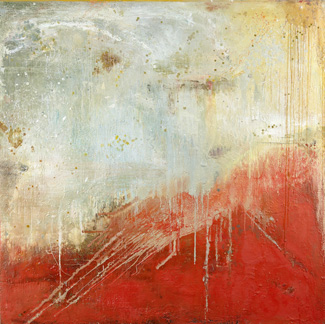 The three of us walked along for bit when the Stephen Haller Gallery caught Tracy's eye: She saw some messy, chunky paintings, and she loves that stuff, so we went in and saw Ron Ehrlich's show. Ron's working in an Abstract Expressionist vein, I guess you'd say, with his all-over compositions and general sloppiness. Clement Greenberg'd probably go on about his shallow picture plane and so forth. I found it decorative in that intentionally non-decorative way some corporations have of decorating their offices. You can see where Ron turned his canvases over to work on them because the drips go down every which way; some pieces have intentional horizon lines; there are clear diagonals to set off the verticals and horizontals of the drips and canvas edges. I found it all kind of precious and calculated, although the more deeply colored canvases -- when Ron got into the reds, for example -- were more striking. Doug and Tracy both seemed to like these, though, oohing and ahhing over the textures of one or how the other one gave a sense of depth with its layers of paint. If Tracy likes a painting she wants to run her hands over it; she's very tactile like that.
The three of us walked along for bit when the Stephen Haller Gallery caught Tracy's eye: She saw some messy, chunky paintings, and she loves that stuff, so we went in and saw Ron Ehrlich's show. Ron's working in an Abstract Expressionist vein, I guess you'd say, with his all-over compositions and general sloppiness. Clement Greenberg'd probably go on about his shallow picture plane and so forth. I found it decorative in that intentionally non-decorative way some corporations have of decorating their offices. You can see where Ron turned his canvases over to work on them because the drips go down every which way; some pieces have intentional horizon lines; there are clear diagonals to set off the verticals and horizontals of the drips and canvas edges. I found it all kind of precious and calculated, although the more deeply colored canvases -- when Ron got into the reds, for example -- were more striking. Doug and Tracy both seemed to like these, though, oohing and ahhing over the textures of one or how the other one gave a sense of depth with its layers of paint. If Tracy likes a painting she wants to run her hands over it; she's very tactile like that.
Next Doug found a gallery I probably would never have seen; Tony Shafrazi is sort of upstairs and not very obvious to me. But Doug found it and so we saw David La Chappelle's Awakened.
When putting together a list of places to go with Tracy and Doug, I had avoided photography because I didn't think they'd be interested. And I was pretty sure I wouldn't be interested either. But I had sort of forgotten that Doug has a photography blog going and is actually very interested in fine art photography, so it was great that he found this show. It also gave us a chance to argue over whether photography qualifies as art, and given the largest photo in David's show, we had a perfect example to argue over.
The first room of Awakened shows flooded and ruined churches, such that I was wondering if they were staged or documentary photos from Katrina-ravaged New Orleans. I know La Chappelle from Rolling Stone; his photos of celebrities were always crazily baroque. I much preferred the photos of Mark Seliger. Since La Chappelle seemed to be a big fan of the staged photo, I couldn't tell where these came from.
 The second room cleared that up. It was dominated by a huge, long mural of a photo of a number of mostly nude people escaping, or caught in, some kind of deluge. The photo so clearly wants to be a classical allegory painting, some kind of modern "Raft of the Medusa," to see it is to realize that photographers really are failed painters. Everything about this photo, from the overwrought lighting to the backdrop which is actually painted, screams "I wish I was Caravaggio -- or at least Ingres." Now, don't get me wrong -- I love photos of naked people. Big fan of nudity. But to stage a painting as a photo just strikes me as strange. Maybe I need a better sense of humor.
The second room cleared that up. It was dominated by a huge, long mural of a photo of a number of mostly nude people escaping, or caught in, some kind of deluge. The photo so clearly wants to be a classical allegory painting, some kind of modern "Raft of the Medusa," to see it is to realize that photographers really are failed painters. Everything about this photo, from the overwrought lighting to the backdrop which is actually painted, screams "I wish I was Caravaggio -- or at least Ingres." Now, don't get me wrong -- I love photos of naked people. Big fan of nudity. But to stage a painting as a photo just strikes me as strange. Maybe I need a better sense of humor.
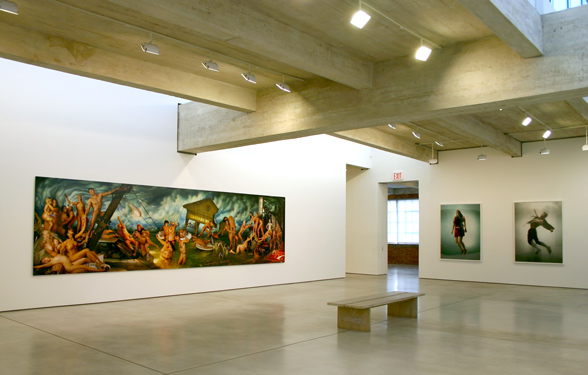 Circling the big photo are a number of smaller, but still larger than life-size, photos of people floating underwater. The people are studiously from all walks of life: Old men and women, skinny people, fat people, a man in a business suit, a woman nude from the waist down, black, white, what have you. Doug seemed to find the photos almost religious, so when he asked me what I thought, I was forced to commit blasphemy. I admitted that I thought they were neat, and a little interesting, but wasn't sure if they were art.
Circling the big photo are a number of smaller, but still larger than life-size, photos of people floating underwater. The people are studiously from all walks of life: Old men and women, skinny people, fat people, a man in a business suit, a woman nude from the waist down, black, white, what have you. Doug seemed to find the photos almost religious, so when he asked me what I thought, I was forced to commit blasphemy. I admitted that I thought they were neat, and a little interesting, but wasn't sure if they were art.
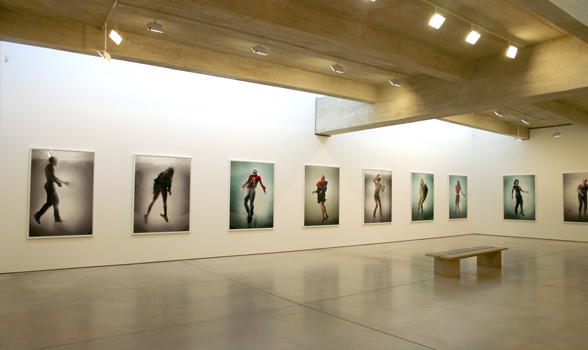 It's always fun to have an argument over whether photographs are art or not. Doug tried to convince me. Tracy, for her part, admitted that she used to agree with me, but Doug had talked her onto his side. Doug tried to tell me abut how many choices the photographer makes, about the intention of the work. He pointed out the bubbles visible near one person, and asked me how I could not find that beautiful. He explained all the work that goes into making a photograph and asked what made it different from the work going into a painting.
It's always fun to have an argument over whether photographs are art or not. Doug tried to convince me. Tracy, for her part, admitted that she used to agree with me, but Doug had talked her onto his side. Doug tried to tell me abut how many choices the photographer makes, about the intention of the work. He pointed out the bubbles visible near one person, and asked me how I could not find that beautiful. He explained all the work that goes into making a photograph and asked what made it different from the work going into a painting.
In the end I wasn't convinced. I am still of the opinion that what makes a photo worth looking at is that it's of something real -- even if it's something Photoshopped, at some point, there was a real thing in front of a camera. And ultimately that's what keeps it from being art, in my opinion: It's not a communication from deep inside a human being, it's a document of a moment in the physical world. Staged or not. And, at bottom, I'm interested in people, not in images of people.
Although I did thank Doug for finding the show, because in the third room there was a topless photo of Pamela Anderson, and I haven't seen her boobs in a while. So that was okay.
There was more to David's show, and we did take it all in, but eventually we tore ourselves away and walked uptown a block to see if Ed Winkleman was around. He wasn't, alas, and some people in his gallery were putting together the next show, so we went next door to Schroeder Romero where we met Sara Jo Romero and saw Michael Waugh's show Lead Me Astray.
What I think I've been seeing over the past year or so is the rise of the obsessive-compulsive artist. Many artists seem to have an obsessive-compulsive streak in them, but some are more insane than others, and I feel that I've been seeing more and more of the really crazy ones in galleries. Michael Waugh represents some kind of weird pinnacle so far: What appear to be pencil drawings turn out to be text, written longhand, forming the lines of a drawing. Doug was pretty sure that the text of George Washington's speeches had been used to form the drawing of The Assumption, showing our first president possibly being assumed bodily into Heaven.
The net effect is like wandering into a benign version of one of those serial killer lairs they show in the movies, where the walls are lined with cut-apart photo collages and notebooks crammed with incomprehensible theories are stacked all over the floor. I squinted, tried to make some sense of the words, realized no sense could possibly be made, and moved on to the next one.
Michael also had a video playing, which I didn't watch, of course, and a piece commenting on the Art Basel/Miami fair which was mostly made up of printouts from the Web of various galleries' verbiage.
I found the show curiously over- and underwhelming. There was a lot of motion for very little noise. The only real questions that came up were, if someone bought one of the pieces, would they read all of it? Would they try? Would it matter if they did? My guess is no, no, and no.
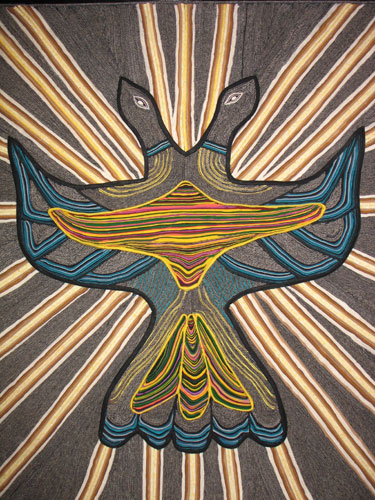 After that we headed east along 27th Street, checking through the windows and doors of any galleries that looked interesting. Doug dragged us in to Foxy Production and their show Surface Wave, which I found deeply uninteresting. Eventually we fetched up at 547 West 27th, a building with a number of galleries, most notably Priska C. Juschka Fine Art, where I was looking for Carolyn Salas. Her show turned out to be wacky, one of those collections of pointless and incongruous objects -- a two-headed bird tapestry! Little mirrors hung from the ceiling! Dreamcatchers! -- which I guess was some kind of symbolic tour of some subject the artist cares deeply about or something.
After that we headed east along 27th Street, checking through the windows and doors of any galleries that looked interesting. Doug dragged us in to Foxy Production and their show Surface Wave, which I found deeply uninteresting. Eventually we fetched up at 547 West 27th, a building with a number of galleries, most notably Priska C. Juschka Fine Art, where I was looking for Carolyn Salas. Her show turned out to be wacky, one of those collections of pointless and incongruous objects -- a two-headed bird tapestry! Little mirrors hung from the ceiling! Dreamcatchers! -- which I guess was some kind of symbolic tour of some subject the artist cares deeply about or something.
Tracy and Doug were both much more taken with John Sparagana's work, which consisted of images from magazines and such sliced into thin ribbons and then glued back together. Sometimes two images seemed interpolated, sometimes a single image seemed duplicated -- I found the images too murky and muddled to look like much of anything. I thought they were aesthetically unpleasant and purposeless, kind of like listening to a poorly tuned-in radio station. Doug seemed to like that and thought the amount of effort involved in the pieces somehow redeemed them.
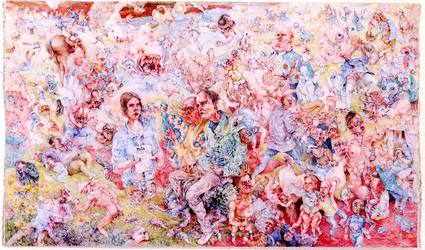 In the same building we also saw Peter Feiler at Galerie Adler. Peter's Ausstellung was titled Mankind - Nature - Technology. His work reminded me strongly of Kelli Williams, only nowhere near as sophisticated; Peter also seems to be another of those obsessive-compulsives I mentioned earlier. Altogether I found his work to be colorful, bizarre, twisted, and boring.
In the same building we also saw Peter Feiler at Galerie Adler. Peter's Ausstellung was titled Mankind - Nature - Technology. His work reminded me strongly of Kelli Williams, only nowhere near as sophisticated; Peter also seems to be another of those obsessive-compulsives I mentioned earlier. Altogether I found his work to be colorful, bizarre, twisted, and boring.
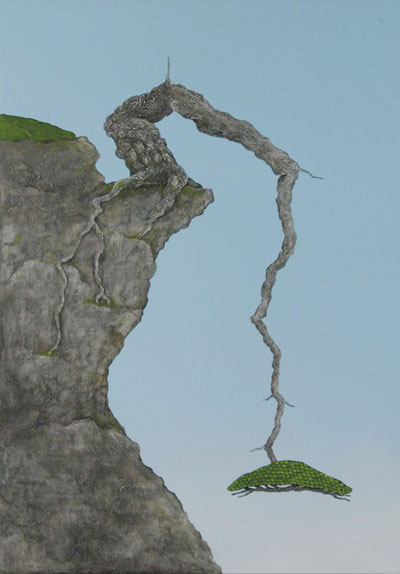 Another obsessive artist was on display at PH Gallery which was showing Shuji Yamamoto. Shuji's wall-hung work -- I'm not sure they were really paintings -- were like little artificial bonsai gardens with carefully repeated patterns of leaves; and his sculpture consisted of fake rocks and sand on the floor. I was tempted to step in the sand but refrained.
Another obsessive artist was on display at PH Gallery which was showing Shuji Yamamoto. Shuji's wall-hung work -- I'm not sure they were really paintings -- were like little artificial bonsai gardens with carefully repeated patterns of leaves; and his sculpture consisted of fake rocks and sand on the floor. I was tempted to step in the sand but refrained.
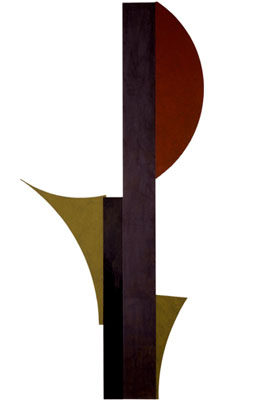 We saw a few more things in that building, but nothing to write home about. We also went through Sundaram Tagore and saw Merrill Wagner's show Flowers. The gallery verbiage calls the work paintings but I immediately thought of them as sculpture: Each work is flat and hung on the wall, but made of geometric plates of steel, some painted. I thought they were rather neat but I couldn't get overwhelmingly excited about them.
We saw a few more things in that building, but nothing to write home about. We also went through Sundaram Tagore and saw Merrill Wagner's show Flowers. The gallery verbiage calls the work paintings but I immediately thought of them as sculpture: Each work is flat and hung on the wall, but made of geometric plates of steel, some painted. I thought they were rather neat but I couldn't get overwhelmingly excited about them.
Eventually we made our way to 25th Street, where we saw so much I think I'm going to save it for another post. Consider this part one. Part two will be up soon.

